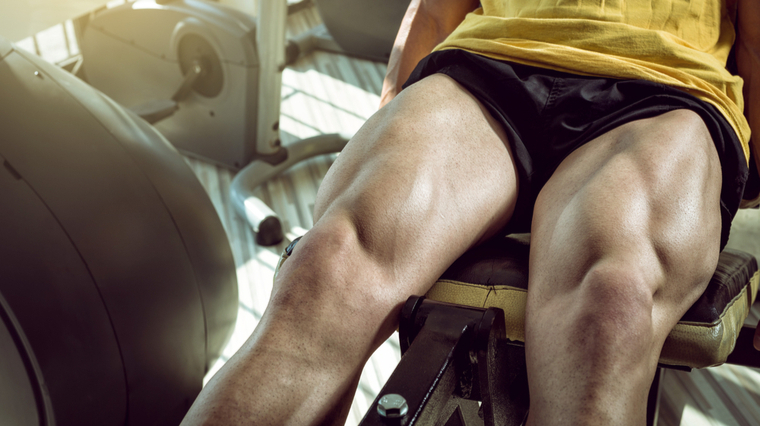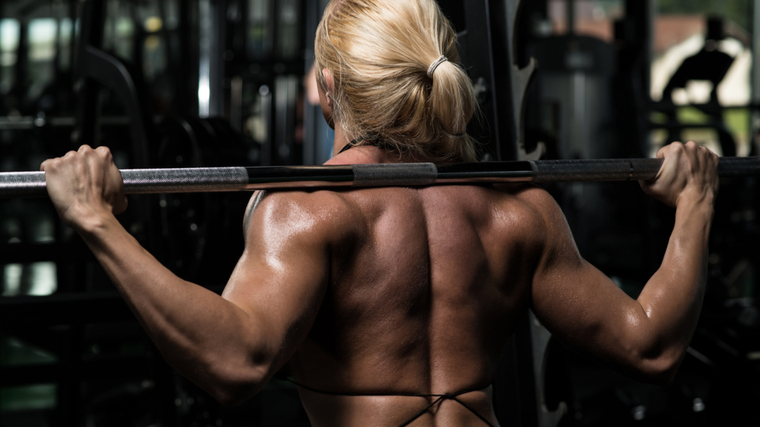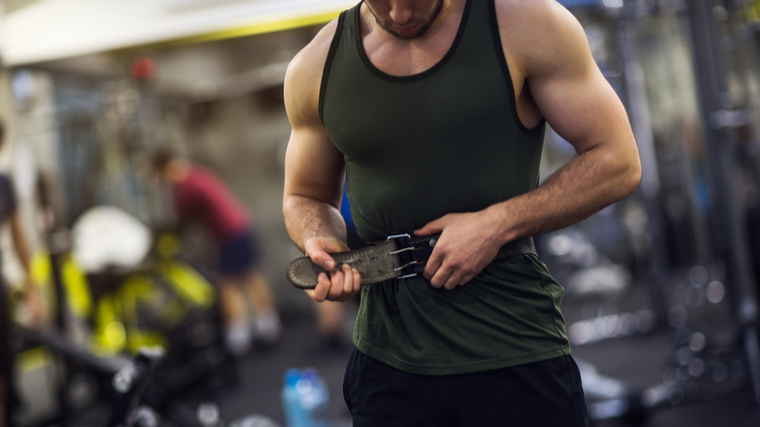Legs win bodybuilding competitions, period. Moreover, a well-developed lower body contributes to the coveted “X” shape and signals to everyone else in the gym that you take your training seriously.
You can’t build big legs sitting on your butt, either. For these reasons (and plenty more), if you’re an aspiring physique athlete, building your wheels needs to be at the forefront of your mind.
Plenty of guys and gals have capped delts or chiseled chests, but only the brave venture into the pain cave and come out the other side with quads that turn heads and drop jaws. If you want to make strides toward developing the best version of your physique, you need the right leg routine to get you there. Look no further.

The Best Bodybuilding Leg Workouts
- Beginner Bodybuilding Leg Workout
- Intermediate Bodybuilding Leg Workout
- Advanced Bodybuilding Leg Workout
- Quad-Focused Bodybuilding Leg Workout
- Hamstring-Focused Bodybuilding Leg Workout
Beginner Bodybuilding Leg Workout
For fresh-faced gymgoers, leg workouts are both a necessary evil and a rite of passage. You’ll likely find it more difficult to acclimate to serious lower-body training than you would a run-of-the-mill arm workout.
Fortunately, you don’t have to kill yourself every session to start building up your quads, hamstrings, and glutes.
The Workout
To set yourself up for long-term success, you need to get comfortable with the major movement patterns found in all well-made leg workouts. Accomplished bodybuilders know how important it is to squat, hinge, and lunge properly.
However, leg training isn’t as biomechanically simple as working your upper body. It takes time and patience to find the right technique for your body type. As such, your leg workouts shouldn’t ask too much while you’re still finding your groove.
- Goblet Squat: 3×8
- Deadlift: 3×5
- Step-Up: 2×10
- Leg Extension: 1-2×15
- Leg Curl: 1-2×15
- Calf Raise: 3×10
How to Progress
You have two duties as a new bodybuilder working your legs — get comfortable and get mobile. Heavier weights and higher volume come after. Each session, focus on refining your form on each exercise and becoming consistent. It’s okay to make adjustments, but don’t try to reinvent your deadlift every time you grab the bar.

[Read More: Best Upper Chest Exercises for Building Muscle]
Once you’ve settled into your technique somewhat, improve your flexibility and mind-muscle connection with controlled eccentric tempos and utilize your full range of motion. Of course, if the sets are simply too easy, slap on another five or ten pounds where you can.
Intermediate Bodybuilding Leg Workout
For the three-to-six-years-in crew, the name of the game is tolerance. Once you have adequate mobility and are comfortable with the various movements commonly found in lower-body training, your real test is applying effort.
As an intermediate, you’re actually in the sweet spot for gains if you apply the right training techniques. You have enough familiarity with physical training to not be overly concerned with technique and form, and also have plenty of upward mobility in terms of strength and size potential.
[RELATED: Best Mobility Workouts]
The Workout
Personalized exercises, varied rep schemes, and a few tactical high-intensity techniques will have your legs growing in no time. It will not, however, be a walk in the park.
Plenty of lifters with a few years under their belt make the novice error of going too hard at the start of their leg workouts and running out of gas at the end. Be smarter than that.
- Warm-Up: 5-10 minutes on the incline treadmill or elliptical
- Back Squat or Front Squat: 3-4×6-8
- Hip Thrust or Stiff-Leg Deadlift or Good Morning: 4×8-12
- Single-Leg Leg Press or Walking Lunge: 3×12-15 reps per leg
- Leg Extension: 3×8,12,15 as a pyramid
- Leg Curl: 3×8,12,15 as a pyramid
- Calf Raise: 60-rep cluster set
How to Progress
Making progress as an intermediate may not be as simple as regularly adding five pounds to all your lifts, but don’t fret. There are more ways to intensify your workouts. If you’re pushing too heavy and can’t hit your target rep range, or your form breaks down, don’t be afraid to peel a bit of weight off and add another set instead.
More volume and perhaps even cutting down your rest times can increase both your total workload and the density of that work. As long as you’re providing a stronger stimulus in some way than the week prior, you’re encouraging new muscle growth.
Advanced Bodybuilding Leg Workout
If you want legs that would make Tom Platz blush, you’re going to have to dig deep each and every time you set foot into the gym. Your legs host some of the largest and most powerful muscles in your body — your quads and glutes in particular.
Getting them to grow after years of consistent training may feel like an uphill battle, but it is certainly doable.
The Workout
Leg training at a high level follows many of the same rules as any other muscle group — the only difference is that the total work you perform each session is far higher than what you’d do for your arms, shoulders, or even your back.
As such, make sure that your diet is on point and can properly fuel heavy, grueling workouts week after week. Furthermore, pay special attention to your energy levels and pace yourself. If you go too hard on your first two movements, you might run out of steam before you fully fatigue all your tissues.
- Warm-Up: 5-10 minutes on the incline treadmill or elliptical
- Pre-Exhaustion: 2 sets of 20 unweighted lunges
- Front Squat or Hack Squat: work up to a heavy set of 6-8, then 3-4×10-12
- Hip Thrust superset Single-Leg Romanian Deadlift: 4×6-8+10-12
- Cyclist Squat superset Good Morning: 3×15+15
- Leg Extension: 3×8, then two drop sets
- Leg Curl: 3×8, then two drop sets
- Calf Raise: 4×20
How to Progress
Make no mistake — it’s quite difficult to up the ante on your workouts if you’ve been training for a long time. If traditional progressive overload worked indefinitely, you wouldn’t need fancy techniques like drop sets or an assortment of different exercises.
As an advanced bodybuilder, you have to pay attention to the finer details of your training to drive progress. Make sure your form is impeccable. Know which exercises are safe to push to absolute failure and, more importantly, when to pull your punches as well.
Beyond that, add weight where you can. Add sets when possible, as long as it doesn’t compromise your recovery or the overall level of effort you bring to the gym. Above all, be very very patient and accept that you may not see massive visual changes on a month-to-month basis.
Quad-Focused Bodybuilding Leg Workout
If you’ve got wimpy quads, you may feel a bit shy about wearing shorts — never mind stepping on a bodybuilding stage. Fortunately, it’s pretty easy to tailor your leg days to emphasize quad growth.
From a program design perspective, quad training is pretty simple. Your knee is a hinge joint and moves in only one direction. Therefore, any exercise that involves bending and straightening the knee will torch your quads, whether it be high-load, low-rep squatting or long sets of lunges up and down the gym.
The Workout
Putting quad growth first and foremost doesn’t mean neglecting your posterior chain entirely. You’ll just want to do more squatting than pulling, as well as hit up your quad-focused exercises early in the workout while you’re fresh and energized.
- Leg Extension: 3×15 with a very light weight as a warm-up
- Front Squat: 4×6
- Leg Press: 3×6,8,12+ as a pyramid
- Bulgarian Split Squat: 3×12-15
- Leg Extension: 3×12-15, then two drop sets
- Leg Curl: 2×8-10
- Calf Raise: 2×20
Hamstring-Focused Bodybuilding Leg Workout
You may not be able to see them in the mirror without feeling like a contortionist, but your hamstrings carry a lot of weight in how your physique looks from the back and sides.
Big, beefy hamstrings also signal to the gym that you’re not afraid to pull heavy — but make no mistake, you don’t necessarily need a 500-pound-plus deadlift to grow them (though it certainly helps).
The Workout
Growing your backside means mastering the hip hinge. However, you don’t want to gas yourself out by performing too many heavy deadlifts first thing in your session, especially if you like working with a lot of volume overall. You also shouldn’t neglect quad work entirely.
- Back Extension: 3×15 with just bodyweight as a warm-up
- Romanian or Stiff-Legged Deadlift: 4×8
- Leg Press: 3×8
- Hip Thrust: 3×8,10,12 as a pyramid
- Prone Hamstring Curl: 3×12, with a drop set at the end
- Nordic Curl: 2×5
- Leg Extension: 2×15
Anatomy of the Legs
Your lower body is the home of a majority of your overall muscle mass (even if you habitually skip leg day). While the ankle and knee joints are pretty straightforward from a structural perspective, the hip is not.
To train your legs optimally, you need to have a working knowledge of each muscle and its primary behaviors.
Quadriceps
Your quadriceps is a four-headed (hence “quad”) muscle group located on the front of your thigh. The vastus medialis, intermedius, and lateralis may be anatomically distinct, but for training purposes, they all extend the knee.
The fourth compartment of the quadriceps, the rectus femoris, actually crosses both the hip and knee joints. This means that for complete quad development, you can’t hang out on the leg extension machine all day. You need movements like the squat that incorporate a bit of hip flexion as well.
Broadly speaking, any exercise that forces you to bend and straighten your knee against resistance will adequately stimulate your quadriceps. The nuance comes from whether you want to do it with heavy squats or high-rep isolation work, but you’ll probably see the best results by mixing both.
Hamstrings
The hamstring muscle group runs down the back of your thigh and has a highly unique anatomical function — it both bends the knee while straightening the hip.
This unique behavior is what actually enables the human gait cycle, but when it comes to bodybuilding, can make hamstring workouts a bit puzzling. To get your head around how your hamstrings work, think of the muscle group (which does have distinct sections that all perform the same function) as a rubber band.
[Read More: The Best Quad Exercises and Quad Workouts for Muscle Gain]
If one end is fixed while the other pulls, there’s tension — think of a Nordic curl where your knee bends but your hip is static, or a good morning where the inverse occurs. But, if both your knee and hip flex simultaneously, there’s slack in the tissue. This is why most squats are ineffectual for stimulating your hamstrings.
Glutes
Although they mainly affect the hip joint, your glutes absolutely come into play during your leg workouts. The gluteal muscles — maximus, medius, and minimus — control the stability and movement of your hip joint.
Practically speaking, you’ll get some glute work any time you stand up out of a deep squat or lock out a deadlift. They also do plenty of work during single-leg exercises, both in terms of completing the rep itself and providing some stability while you stand on one limb.
Calves
The two calf muscles — the gastrocnemius and the soleus — stand in isolation. Their anatomical separation from the knee and hip are part of why they can be so stubbornly hard to grow, since you need to perform dedicated isolation work on them. You won’t grow your calves by squatting, unfortunately.
They’re also notoriously stubborn and may need inordinate amounts of volume to induce hypertrophy. After all, you (hopefully) spend a good portion of the day walking around.
When you’re in the gym, make sure you perform both seated and standing calf raises to target both heads of the muscle.
Should You Wear a Lifting Belt on Leg Day?
In short, probably. There are plenty of myths and misinformation floating in the airwaves of most gyms about what lifting belts do (or don’t do), so it’s especially important to separate fact from fiction if you’re considering picking one up.
First and foremost, belts do in fact help stabilize your spine. If you’re working with heavy loads or training near failure with free-weight compound lifts, a belt will help you maintain rigidity and integrity so you can focus on working hard. (1)
On the other hand, you may have heard that heavy compound lifting thickens the waist — something that bodybuilders don’t necessarily want. Fortunately, some literature suggests that wearing a lifting belt actually decreases the activation of your obliques and demands more of your abs. This may mean that belted training can help create a tight and well-developed midsection to some degree. (2)(3)

Moreover, belts unequivocally help you lift heavier weights or squeeze out more repetitions safely, an effect that has been widely corroborated in research. (4)
All in all, there’s little reason to forgo a good lifting belt if you’re trying to grow your legs. Feel free to slap it on when you’re working with heavy free weights.
Get a Leg Up
Serious leg training isn’t for the faint of heart. If you want to be a bodybuilder, you can’t be all wit and no grit. Programming smarts and a tactful diet can take you far, but some muscles simply won’t grow unless you force them to.
Fortunately, the right leg workout can make a sometimes-painful process both effective and fun. You don’t need to keel over the trash can between sets of squats, but you should probably be prepared to work harder than you’re used to. Fortunately, the results are well worth it — bigger legs will help you run faster, lift heavier, and look better both in and out of the gym.
References
1. Miyamoto, K., Iinuma, N., Maeda, M., Wada, E., & Shimizu, K. (1999). Effects of abdominal belts on intra-abdominal pressure, intra-muscular pressure in the erector spinae muscles and myoelectrical activities of trunk muscles. Clinical biomechanics (Bristol, Avon), 14(2), 79–87.
2. Escamilla, R. F., Francisco, A. C., Kayes, A. V., Speer, K. P., & Moorman, C. T., 3rd (2002). An electromyographic analysis of sumo and conventional style deadlifts. Medicine and science in sports and exercise, 34(4), 682–688.
3. Warren, L. P., Appling, S., Oladehin, A., & Griffin, J. (2001). Effect of soft lumbar support belt on abdominal oblique muscle activity in nonimpaired adults during squat lifting. The Journal of orthopaedic and sports physical therapy, 31(6), 316–323.
4. Lander, J. E., Hundley, J. R., & Simonton, R. L. (1992). The effectiveness of weight-belts during multiple repetitions of the squat exercise. Medicine and science in sports and exercise, 24(5), 603–609.
Featured Image: I T A L O / Shutterstock